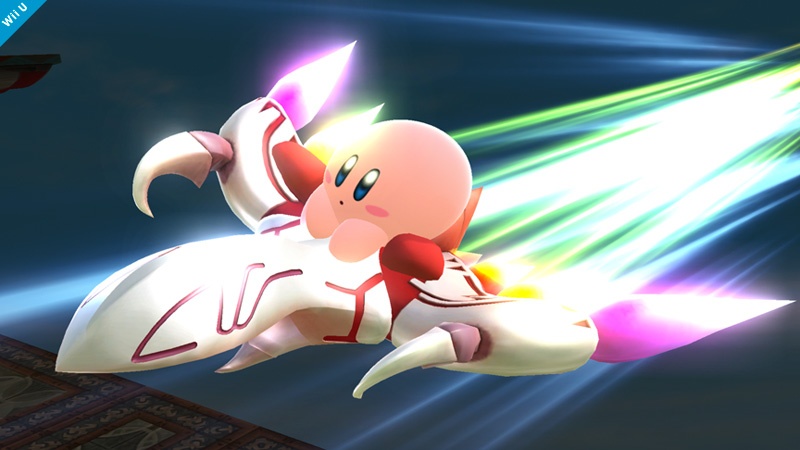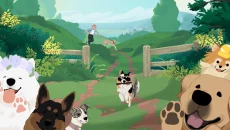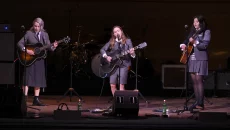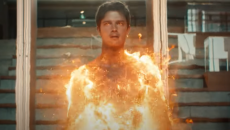Kirby rides dragoon, a secret vehicle only playable in City Mode. (Courtesy of Nintendo)
Both reviewers and fans in general tend to have very strong attachments to Nintendo Gamecube games. It seems as though there is a very clear upper echelon (“Super Mario Bros Melee”, “Metroid Prime”, “The Wind Waker”, ect.) and any other game is just considered bad. It may be natural to come to the conclusion that the classic Gamecube games raised the bar so high, it’s hard for other games to compete. “Kirby Air Ride”, a “Kirby” themed racing game released in 2003 is one of the victims of this phenomenon. If you were to search for this title online, you might find five negative reviews before even one positive. The internet seems determined to keep “Mario Kart: Double Dash” as the definitive Gamecube racing game, but while “Mario Kart: Double Dash” is amazing, and there are issues with “Kirby Air Ride”, this title gets hated on way more than it probably should.
One interesting thing to note about “Kirby Air Ride” is, despite efforts to have you believe it is a bad game, it still managed to crack the top 20 highest selling Nintendo Gamecube games of all time. To put that in perspective, it sold more than beloved titles such as “The Legend of Zelda: Twilight Princess”, “Super Mario Strikers”, and “Soulcalibur II”.
“Kirby Air Ride” was developed by HAL Laboratory, the same developer that brought us “Pokemon Snap” and “Super Smash Bros. Melee”, among others. The game features three modes, one being noted by fans as particularly much more fun than the other two. The main mode in the game, known simply as Air Ride, is the main racing mode in the game, where players can race on multiple tracks. The second mode, known as Top Ride, is a different racing mode that features an overhead perspective and smaller tracks with tighter turns.
While these modes are fun to play, most fans of the game agree that they are next to irrelevant. The main draw of this game is known as City Mode. In city mode, four players are placed into a Kirby themed city with warp stars (the “cars” in this game). The city is huge, filled with various power ups that can improve the stats of the player’s warp star. Other collectibles in the game lower those stats as well. Also present in this mode are various weapons that can be used on other players.
At the end of every City Mode session, there is a competition known as a Stadium Event. These take many forms, including everything from a contest to see how far your warp star can glide, to a regular race on one of the Air Ride tracks. During your time in City Mode, hints will appear as to what the Stadium Event is, so that the players might power up their warp stars accordingly.
In theory, the goal of City Mode is to power up certain stats in such a way that it would lead you to have the best chance at winning the Stadium Event. Amongst players of the game, however, this goal is considered inferior to the more popular goal of finding where the other players are on the map and using weapons on them to destroy their warp star and force them to search for another. In all seriousness, some would consider this game as a precursor to free for all deathmatches in the “Call of Duty” series. The map in this mode contains various areas, some of which are very difficult to find (ice area under the volcano and the observatory at the top of the map are two of many). As a party game to play with friends, it’s often more entertaining to see how many times you can spot your friends, and completely ignore the Stadium Event.
While the other modes may not be as popular, both are fun in their own right. As a racing game, the Air Ride mode has very unique controls which, while they won’t bother everyone, will dampen the experience to some. For one thing, the player does not have to press a button in order to accelerate. While in most other racing games, the A button is usually designated to move the character, in “Kirby Air Ride”, the A button is the break. It is a very unique break that is actually used to drift around corners. There are also power ups in the game that can be accessed by using Kirby’s signature inhale of enemies to gain their abilities for a short time. These enemies are present on the track, and the inhale command is also performed by pressing the A button when close to an enemy.
Many critiques of the game cite the unique controls as detrimental to the game because it takes a while to get used to. Here is where the game gets bodied online in reviews somewhat unfairly. Yes, there is a transition period that is somewhat annoying, but once that period’s overcome, it’s not an issue. Someone who is a big fan of racing games that is accustomed to a certain button layout might find this problematic. This control scheme can be learned, though, as it would be in other games such as “Metroid Prime”, “Star Fox 64”, and most “Metal Gear Solid” games, where there are elaborate control schemes that the player needs to practice some.
Outside of the control scheme, which some critics can’t ignore as a major flaw, this game also features great variety in a number of facets that add intrigue to the game. First of all, there are numerous types of vehicles. Of course, every racing game features different vehicles with different graphics and sometimes different stats. In the case of “Kirby Air Ride”, though, it goes much further than a different paint job. Each warp star has a different ability that leads to different racing mechanics in each race. There are sixteen in total, and they each have unique stats, and most have unique features, such as an extremely fast warp star that can only turn when the A button is pressed, or one that is much faster in the air than on land.
Secondly, the levels are designed beautifully. No one track is the same, and they all feature tight turns and fun mechanics. Most of them have multiple different lanes, so much in fact that it would be unfair to call them secret passageways since a lot of them are in plain sight. Part of racing on these tracks is determining which lane is best to take at any given situation, meaning that no two races are exactly alike.
Top Ride is the third mode, but it’s rather like the second. It has smaller tracks and only two vehicles, but it is certainly fun. Most owners of the game play the other two modes much more frequently than this one, however.
At the end of the day, there are too many unique features in this game to result in a unanimous approval or disapproval. The fan base is extremely divided, and the control scheme will be too much for some people. Despite these claims, the game is loads of fun though. It may be unique and hard to learn, but people have fun in the process.




